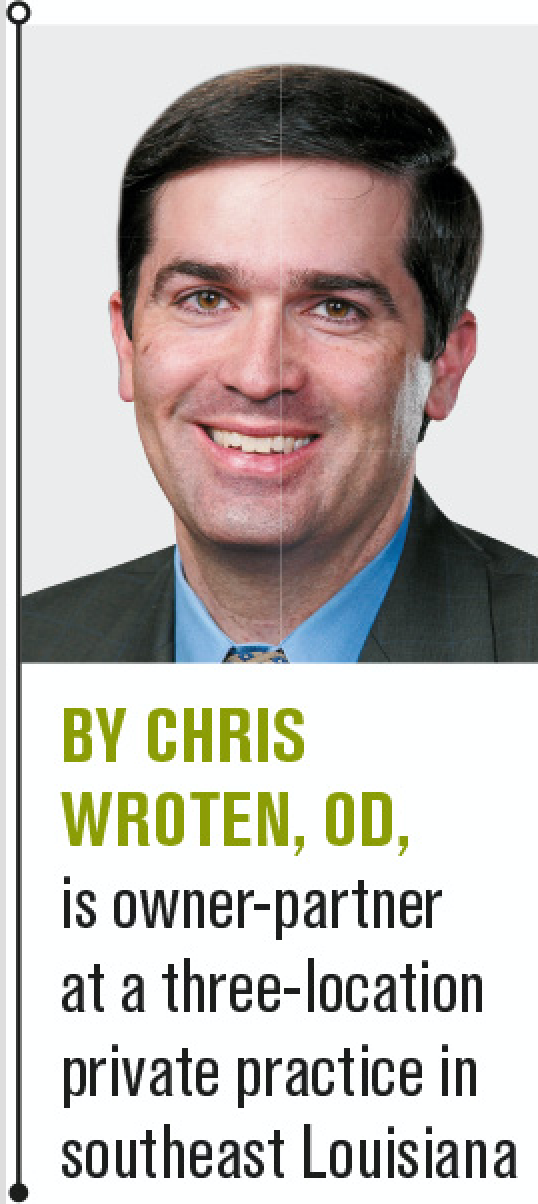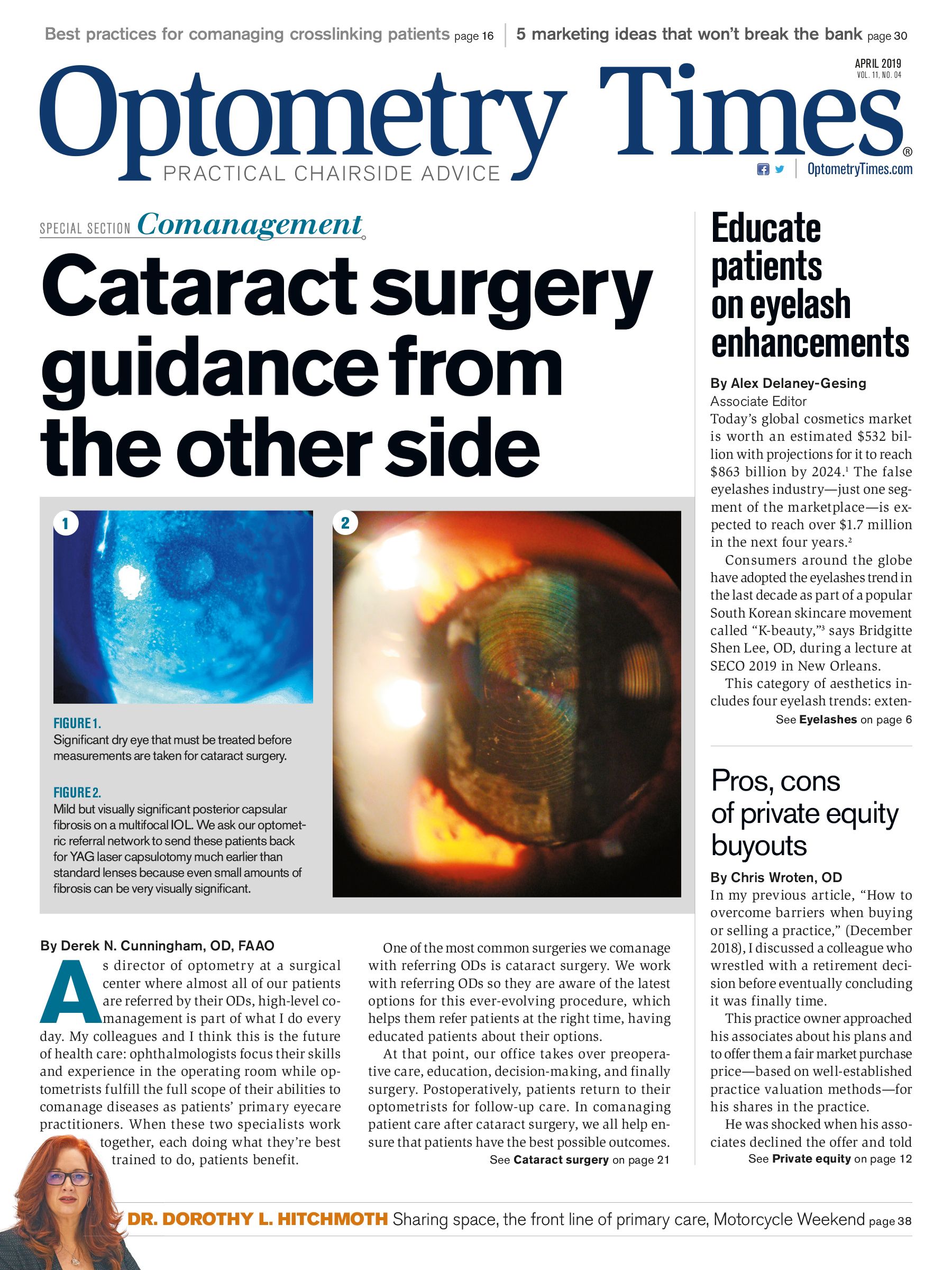Pros and cons of private equity firms in practice transitions


In my previous article, “How to overcome barriers when buying or selling a practice,” (December 2018), I discussed a colleague who wrestled with a retirement decision before eventually concluding it was finally time.
This practice owner approached his associates about his plans and to offer them a fair market purchase price-based on well-established practice valuation methods-for his shares in the practice.
He was shocked when his associates declined the offer and told him they weren’t interested in owning the practice because they didn’t see any value in it.
Industry-wide dilemma
Unfortunately, one of the most important but overlooked aspects of practice management is managing a practice sale on the back end of a career.
While each situation is different, many ODs are struggling with some form of the same question: “How do I transition out of my practice?”
Some ODs are simply walking away and receiving nothing in return for their practices. This scenario is unfolding more frequently in medicine and other healthcare professions as well, which forces us to ask: Is the traditional sale of a private practice to a new owner in danger of extinction?
On the other side of the coin, some ODs are asking, “How do I transition into practice ownership?” but face difficulty with making it happen.
While there’s no right or wrong position, both situations make for a challenging landscape for sellers.
Let’s discuss one option for those undergoing a practice transition as well as the accompanying challenges faced by sellers-a decision my colleague ultimately chose: private equity.
Also by Dr. Wroten: How to know if a professional employer organization can work for you
Private equity
Private equity firms are limited partnerships that utilize capital not publicly listed or traded to buy, streamline/restructure, and resell private companies for profit.1,2
Several years ago, a number of these companies held a surplus of investable funds and were looking for new, high-return investment opportunities.
Eye care was identified as one possibility due to the aging U.S. population and its associated needs; the potential for cash-based, premium eyecare service offerings, and an isolated business landscape that lent itself to consolidation.3
Perhaps the first such transaction in the ophthalmic space occurred in 2014 when Varsity Healthcare Partners recapitalized Katzen Eye Group to form EyeCare Service Partners, before Varsity Healthcare Partners profitably exited the entity three years later in a transaction with Harvest Partners.4
Following that success, Friedman Fleischer & Lowe (FFL) Partners recapitalized Clarkson Eyecare and created EyeCare Partners in 2015.3 Several other firms since then have also been actively acquiring ophthalmic practices, including MyEyeDr., Total Eye Care Partners (via Imperial Capital and HW Holdings), and Acuity Eyecare Group (Riata Capital Group).
Interest in these options continues to increase in ophthalmology as well. I recently attended a session at the American Society of Cataract and Refractive Surgeons, at which a jam-packed audience assembled in a large ballroom to learn more about private equity transactions.
Related: Visibly (formerly Opternative) still the same company
While several different companies have been mentioned, it is difficult to find a comprehensive listing of all private equity firms currently acquiring ophthalmic practices. But just to provide a measure of the activity, one list published in 2018 includes 31 firms.5
It should also be noted that not all private equity firms are created equal, nor do they operate the same. Some are looking to partner with ODs and have them stay on indefinitely, while others are willing to assist with a doctor’s exit plan. Individual strategies and differences abound, but there are generally two main models of operation: centralized and decentralized.
Centralized model
In this model, the acquiring company assumes all administrative and management functions, including billing, collections, optical, equipment purchasing, and acquisition.
All practices acquired by the firm employ this centralized management model and even utilize the same electronic health record (EHR) system, seeking to increase efficiency, control, and cost savings.
As more practices are acquired, the goal is usually to maximize short- to medium-term profits in order to make the future consolidated sale of the acquired entities as attractive as possible within a three- to seven-year timespan.6
Decentralized model
This model utilizes less centralized management, resulting in a smaller corporate structure.
The acquired practice has more freedom to continue operating the way it was prior to the acquisition, with incentives to grow internally and via additional local acquisitions.
A previous owner may retain more control of the practice’s day-to-day decisions, and may receive money and stock in the purchasing entity. This is also an option with some centralized models.5
Related: Blog: How to calculate your compensation as a practice owner
Exclusions
A variant of these two models employs a much longer- term perspective to grow both internally and externally, thereby increasing practice profitability.
As additional practices are acquired and incentivized to maximize individual practice profits, the entire purchasing entity grows organically. With this model, ODs invest only in their own practice, with no plans of a future sale-similar to a venture capital investment.5
For ODs looking to exit a practice, this model and the decentralized model may not be as applicable.
Overall
Regardless of the model, these transactions yield a lump sum of cash for the selling OD up front in exchange for reduced future income. The lump sum is taxed as capital gains, based on current practice profits-earnings before interest, taxes, depreciation and amortization (EBITDA). Additionally, the selling doctor(s) may receive stock in the new entity.6
So, what are the pros and cons of a private equity practice transition?
Pros
Private equity transactions may occur more quickly than a traditional sale.
After speaking with colleagues who have gone through both, the traditional practice sale to another OD may take three to five years from start to finish, while a private equity transaction may be fully completed in one to two years-not including additional time the owner may be required to stay on staff.
Additionally, private equity groups seem to be offering more for practices than traditional practice valuation models would suggest, resulting in larger up-front cash payouts.
Specific transaction terms vary and can be negotiated. However, after the deal is completed in the centralized model, the seller no longer needs to address the day-to-day challenges of running a practice and manage merit-based incentive payment system (MIPS), Health Insurance Portability and Accountability Act (HIPAA), cyber-liability, human resources management, bill-paying, and other administrative tasks associated with owning a practice.
The practice itself may achieve added savings on purchases of contact lenses, frames, spectacles, equipment, and office supplies, by leveraging the collective buying power of all the practices in the private equity firm’s group.
Efficiencies may also be gained in billing and collections, purchasing decisions, employee policies and procedures, and other areas of practice management.
Related: How to calculate the value of your practice
Cons
Most transactions require the seller to stay on as an employee of the new entity for a specified amount of time (which can be negotiated as a condition of sale). During this period, the former owner becomes subject to the decisions of the new ownership.
Those decisions may include longer and/or later office hours, opening on weekends, more limited vacation time for the seller, and no longer acting as the primary decision maker for purchases, policies, and procedures-although some of these may be retained in a decentralized model.
The practice may take on a more corporate feel and/or eventually be sold again to another entity over which the original owner has no control.
I spoke to one OD off the record after a private equity transaction. He shared that he had numerous patients in the community tell him, after decades of building a reputation of patient care and trust, they thought the clinic’s new direction was noticeably less patient-centric and more focused on accelerated profits.
For models more focused on maximizing short- to medium-term profits, long-term planning and investment into the practice may become less of a priority.
Profession impact
This begs the question: Is private equity good for the profession?
It’s impossible to blame an OD for selling to a private equity firm, especially if he was unable to find a buyer, offered more than what his practice would have traditionally been valued, or if the rigors of ownership had lost its luster.
However, it remains to be seen what the long-term impact on the profession will be, and this will largely depend on the private equity firm’s strategy.
The optometric profession has historically been led by those with a keen focus on patient care and who are most vested in their profession.
But some private equity transactions may have the potential to de-emphasize patient care and create a more corporate workplace, possibly reducing those ODs’ commitment to their profession’s success.
Private equity transactions also create a potentially tenuous situation in which only large corporate entities may be in position to purchase consolidated practices from private equity firms when they resell them in the future.
Additionally, private equity takes healthy, viable practices off the market, potentially making it harder for younger buyers to transition into ownership.
Lastly, if a seller miscalculates his timeline and finalizes a private equity transaction too soon in his career (>5 to 10 years before he is ready and/or financially able to retire), he could end up on the wrong end of the financial equation when the loss of future earnings and the foregoing of additional equity built into his practice are taken into consideration.
Related: Why ODs need a business strategy
Wrapping up
Perhaps these private equity ventures will ultimately strengthen the optometric profession-allowing practice to leverage buying power as well as take advantage of economies of scale and best business practices
Or perhaps these ventures will fail, creating an opportunity for former owners and new buyers to purchase practices for less than their original prices.
Regardless, there’s much to consider when it comes to any practice transition. The first thing to do is to plan an exit strategy now by examining all options and making an informed decision.
References:
1. Chen J. Private equity. Investopedia. Available at: https://www.investopedia.com/terms/p/privateequity.asp. Accessed 2/4/19.
2. Segal T. What is private equity? Investopedia. Available at: https://www.investopedia.com/articles/financial-careers/09/private-equity.asp. Accessed 3/4/19.
3. Grassa S, Patel, A. How to look at private equity investment in physician groups: Eye care. Ocular Surgery News. Available at: https://www.healio.com/ophthalmology/practice-management/news/online/%7B9b34c9ce-c20e-46e0-80ff-bd0f6e807097%7D/how-to-look-at-private-equity-investment-in-physician-groups-eye-care. Accessed 3/4/19.
4. Harvest Partners. Varsity Healthcare Partners and Harvest Partners announce recapitalization of Eyecare Services Partners. Available at: http://www.harvestpartners.com/varsity-healthcare-partners-and-harvest-partners-announce-recapitalization-of-eyecare-services-partners. Accessed 3/14/19.
5. Harbin TS, Markowitz G. Private equity buyouts of ophthalmology practices - Update 2018. Available at: https://www.aao.org/senior-ophthalmologists/scope/article/private-equity-buyouts-of-ophthalmology-practices-2. Accessed 3/4/19.
6. Tosh, Mark. Panel explores private equity’s evolving role in vision care. Vision Monday. Available at: http://www.visionmonday.com/business/article/panel-explores-private-equitys-evolving-role-in-vision-care/. Accessed 3/4/19.

Newsletter
Want more insights like this? Subscribe to Optometry Times and get clinical pearls and practice tips delivered straight to your inbox.